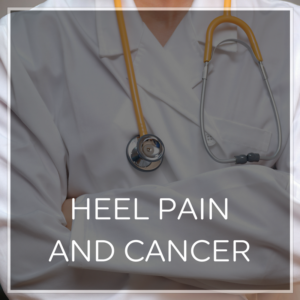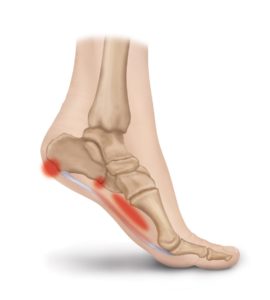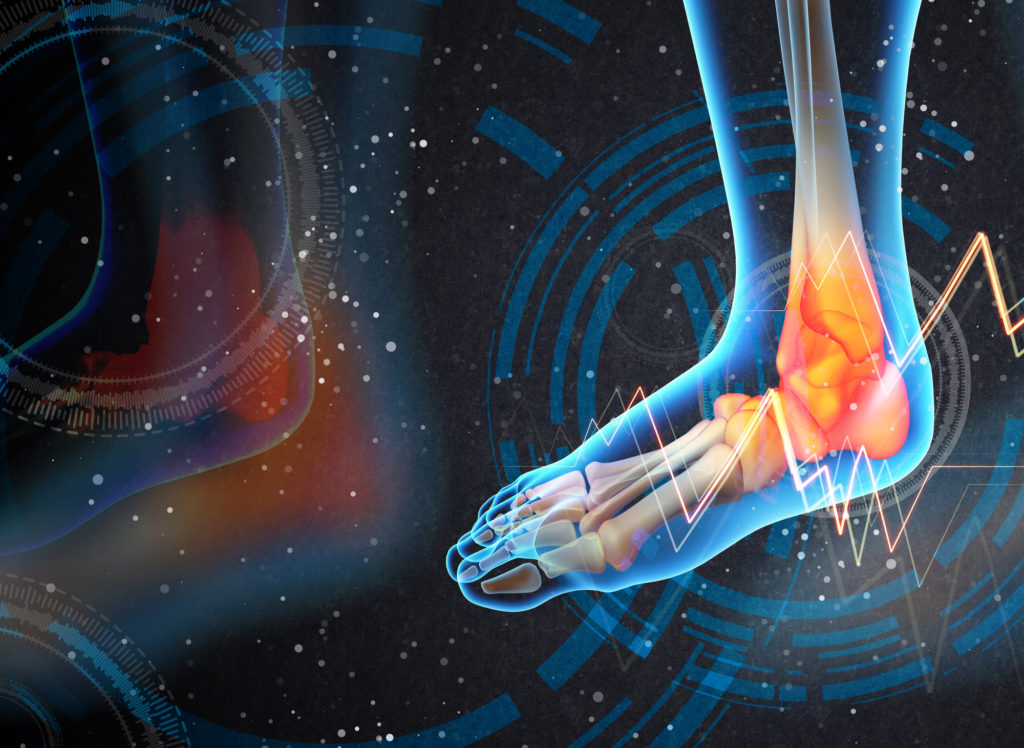 If you’ve been diagnosed with cancer, heel pain and Plantar Fasciitis are likely the furthest thing from your mind.
If you’ve been diagnosed with cancer, heel pain and Plantar Fasciitis are likely the furthest thing from your mind.
However, understanding the unique ways in which cancer may intersect with heel pain–and knowing what to do if heel pain strikes–can help eliminate one more worry and source of pain during an already difficult time.
In this post, we’ll discuss how cancer treatments can contribute to Plantar fasciitis, special considerations for treating heel pain alongside cancer, and whether or not heel pain itself can be an indicator of cancer.
Can Heel Pain Be a Side Effect of Cancer Treatments?
Cancer treatments come with a host of unpleasant, painful, and confusing side effects–as if cancer itself isn’t difficult enough!
Not only can chemotherapy, radiation, and various oral medications cause nausea, extreme tiredness, and hair loss–but they can also contribute directly or indirectly to Plantar Fasciitis and heel pain.
Many of these cancer treatments contribute to loss of bone density and muscle wasting. Both of these side-effects can have a big impact on the arch’s ability to properly absorb the impact from even simple activities like walking. As treatments continue, the arch may flatten and become more susceptible to small tears, stress, and micro injuries. This condition, known as Plantar Fasciitis, can result in mild to severe heel pain.
And while some cancer treatments result in weight loss and drastically reduced appetite (such as chemotherapy), other oral medications can cause rapid weight gain or bloating. This sudden weight gain places a lot of extra strain on the arch of the foot, causing it to flatten and sustain damage.
Treating and Preventing Heel Pain Alongside Cancer

Most cases of heel pain can be treated without costly or invasive medical treatments. Which is good news if you have cancer, since costly and invasive medical treatments are the name of the game.
An incredible 90% of Plantar Fasciitis cases can be resolved without surgery, using treatments including the following:
Orthotics: Orthotic inserts designed to target Plantar Fasciitis (not just the foam grocery store inserts), are one of the best ways to treat heel pain symptoms while actually addressing the root of the problem–a damaged and unsupported arch. These special inserts, called Heel Seats, apply targeted acupressure to relieve pain, lift the arch to an optimal height, provide durable (and washable!) cushioning, and provide the backup your arch needs–all for the cost of a few cups of coffee.
Stretching: Gentle stretches for the heel, ankles, toes, and calves, can have a big impact on your arch’s elasticity and ability to bear weight properly. Many stretches can be done from bed while you rest, for just a few minutes a day. Stretching can also promote improved blood flow and a boost in endorphins, which may be sorely needed during difficult cancer treatment regimens.
Night Splints or Socks: During exhausting cancer treatments, even stretching in bed can be too much effort. Using a night splint (or a sock night splint for extra comfort and softness), you can hold your foot in a gentle stretch all night long, significantly improving the pain from Plantar Fasciitis–especially those first few steps out of bed.
Icing and Self Massage: Simple pain-relief techniques like icing and self massage (with either your fingers or a variety of household items), can make a big difference in your heel pain. Use icing and massage as often as you need throughout the day, spending 10-20 minutes on the injured area.
When Is Heel Pain an Indicator of Cancer?

The vast majority of cases involving heel pain are diagnosed as Plantar Fasciitis or other non-cancerous conditions. However, chronic heel pain can be an indicator of cancer in rare cases. Studies have documented cases in which lung cancer or breast cancer presented as s metastasized lesion on the heel bone, which was initially diagnosed as plantar fasciitis. Other forms of cancer that attack the blood, bones, and lymph nodes may present anywhere in the body and may, at times, show up in the foot or heel.
If you notice unusual (but typically painless) lumps or hard bumps on the feet or heels, there’s no need to immediately assume a diagnosis of cancer, however. Most bumps and lumps are benign and a result of shoes rubbing or irritating the tissues of the foot (including Haglund’s Deformity (pump bump), retrocalcaneal bursitis, and cysts). However, if you notice symptoms like fatigue, swollen lymph nodes, fever, or unexplained weight loss in addition to your heel pain or lump on the foot, it’s important to make an appointment with your doctor. It’s also a good idea to see a doctor for heel pain or bumps on the heel or foot that don’t seem to respond to conservative remedies or seem to be growing.
Remember: In the vast majority of cases, heel pain is an unfortunate side effect of some cancer treatments–not an indicator of the presence of cancer. However, in either case, knowledge is key to healing and your health.
If you’re currently undergoing (or have recently undergone) cancer treatments, and now struggle with heel pain, take comfort in knowing that your heel pain doesn’t have to be one more worry on your mind. With simple, inexpensive home treatment options such as orthotic inserts, stretching, a night splint, and icing and massage techniques, most people can simply and effectively address the condition at home.




I am a retired Orthopaedic surgeon with lung cancer. After the third chemotherapy I experienced left heel pain typical of plantar fasciitis. Your article was excellent and has reassured me completely.
Yes both my heels started hurting on 3rd week. Carboplatin and texotere,
I have lung cancer and have been undergoing IV & oral chemotherapy over some months. Your article was very helpful.iren
After 4 days walking around, climbing 5/6 hours a day….then after a 3 hour drive back to the East Bay…,when I arrived home May 2016…the heel/foot pain was at 10…..my Primary Care Doctor, PT and Acupuncturist told me Planter Fasciitis…I have used since Orthopaedic inserts….A few weeks ago I was much better….then After walking a mile in diff shoes….now back + pain up back of leg a few days and now on up though hip to waist😉….
I’ve worn inserts off and on for years that have helped with callouses. Now undergoing oral chemo for breast cancer I wondered if this was a side-effect or another site of bone metastasis (I have femur and humerus mets). Heel just started hurting last 3 weeks, on and off. I’ll try my old inserts and see if that helps. Thank you. One less worry, I hope.
I was on my 3rd week of chemo and both heels started hurting at the same time. Ive tried everything suggested an have decided i will probably have to wait until treatment is finished for relief. The main problem is walking is very painful and difficult
Having radiation for prostate cancer
I am 3 weeks out of my last chemo being 6 months long. I’ve had before diagnosis and now after chemo, severe heel pain with redness. Curious if this is plantar fasciitis or something else. My chemo was for non Hodgkin’s lymphoma. I had before so worried what this means now that it’s back so bad.